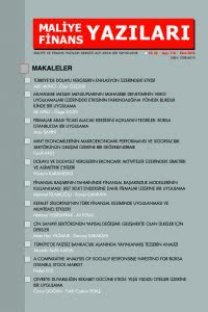PERFORMANS ORANLARININ ÖNEM AĞIRLIKLARI: HEDGE FONLARIN ENTROPİ YÖNTEMİYLE İNCELENMESİ
Bu çalışmada Ocak 1999-Mayıs 2019 döneminde faaliyet gösteren hedge fonların verileri kullanılarak performans oranlarının önem ağırlıkları incelenmek istenmiştir. Çalışmada hedge fon yatırımcılarının yüksek olmasını bekledikleri bilgi, Calmar, Jensen’in alfası, m-kare, Sharpe, Sortino ve Sterling oranları hesaplanmış, bu oranların önem ağırlıkları çok kriterli karar verme yöntemlerinden biri olan Entropi yöntemi ile belirlenmiştir. Sonuçlar Sortino, Sterling ve Jensenin alfası oranlarının önem ağırlıklarının diğer oranlardan daha yüksek olduğunu göstermektedir.
Anahtar Kelimeler:
Performans Oranları, Entropi Metodu, Hedge Fonlar, Getiri, Risk
Importance Weights of Performance Ratios: Analyzing Hedge Funds by Entropy Method
In this study, it is aimed to examine the importance weights of performance ratios by using the data of hedge funds operating in the January 1999-May 2019 period. In the study information, Calmar, Jensens alpha, m-square, Sharpe, Sortino and Sterling ratios, which hedge fund investors expect to be high, were calculated, and the importance weights of these ratios were determined by the Entropy method, which is one of the multi-criteria decision-making methods. The results show that Sortino, Sterling, and Jensen’s alpha ratios have higher importance weights than other ratios.
Keywords:
Performance Ratios, Entropy Method, Hedge Funds, Return, Risk,
___
- Ackermann, Carl., Mc Enally R. and Ravenscraft, D. (1999). The performance of hedge funds: risk, return, incentives. Journal of Finance, 54(3), 833–874. https://doi.org/10.1111/0022-1082.00129
- Agarwal, V., Naveen, D. and Narayan, N. (2011). Do hedge funds manage their reported returns? Review of Financial Studies, 24(10), 3281-3320. https://doi.org/10.1093/rfs/hhr058
- Aragon, G. O. and Nanda, V. (2017). Strategic delays and clustering in hedge fund reported returns. Journal of Financial & Quantitative Analysis, 52(1), 1-35. https://doi.org/10.1017/S0022109016000715
- Bollen N., P.B. and Pool V. K (2009). Do hedge fund managers misreport returns? Evidence from the pooled distribution. The Journal of Finance, 14(5), 1-54. http://dx.doi.org/10.2139/ssrn.1018663
- Canepaa, A., De La O. Gonzalez, M. and Skinner, F. S. (2020). Hedge fund strategies: a non-parametric analysis. International Review of Financial Analysis, 67(1), 1-15. http://dx.doi.org/10.2139/ssrn.3499492
- Cao, C., Chen, Y., Goetzmann, W. N. and Liang, B. (2018). Hedge funds and stock price formation. Financial Analysts Journal a Publication of CFA Institute, 74(3), 54-69. http://dx.doi.org/10.2139/ssrn.2121495
- Chelikani, S., Kilic, O. and Coe, T. (2019). The hedge fund industry’s market timing ability and role in financial contagion: evidence from the strategic response to the 2008 financial crisis. Banking and Finance Review, 1(1), 79-100. http://ccsu.financect.net/FTC205/BFR0920Papers/877-2615-1-PB.pdf
- Duanmu, J., Malakhov, A. and Mccumber, W. R. (2018). Beta active hedge fund management. Journal Of Fınancıal And Quantıtatıve Analysıs, 53(6), 2525-2558. http://dx.doi.org/10.1017/S0022109018000388
- Engert, A. (2010). Transnational hedge fund regulation. European Business Organization Law Review, 11(3), 329-378. https://doi.org/10.1017/S1566752910300036
- Fung, W., Hsieh, D. A, Naik, N. and Ramadorai, T. (2008). Hedge funds: performance, risk and capital formation. The Journal Of Finance, 13(4), 1-43. https://doi.org/10.1111/j.1540-6261.2008.01374.x
- Getmansky, M. Andrew, W. Lo and Makarov, I. (2004). An econometric model of serial correlation and illiquidity in hedge fund returns. Journal of Financial Economics, 74(2004), 529–609. https://doi.org/10.1016/j.jfineco.2004.04.001
- Goetzmann, W., Ingersoll, J., Spiegel, M. and Welch, I. (2007). Portfolio performance manipulation and manipulation-proof performance measures. Review of Financial Studies, 20(5), 1503-1546. http://dx.doi.org/10.1093/rfs/hhm025
- Januzzi, F. V., Bressan, A. A. and Moreira, F. (2020). Opacity, risk, performance and inflows in hedge funds. Revista de Administração Contemporânea. 24(1), 77-99. https://doi.org/10.1590/1982-7849rac2020180233
- Joenväärä, J., Kosowski, R. and Tolonen, P. (2019). The effect of investment constraints on hedge fund investor returns. Journal Of Financial and Quantitative Analysis, 54(4), 1539-1571. http://dx.doi.org/10.1017/S0022109018001333
- Knif, J., Koutmos, D. and Koutmos, G. (2020). Higher co-moment capm and hedge fund returns. Atlantic Economic Journal, 48(1), 99-113. http://dx.doi.org/10.1007/s11293-020-09659-1
- Malladi, R. (2020). Luck versus skill in evaluating hedge fund managers’ performance. Journal of Business & Management, 26(1), 22-39. DOI 10.6347/JBM.202003_26(1).0002
- Shemshadi, A., Shirazi, H., Toreihi, M., and Tarokh, M. J. (2011). A fuzzy VIKOR method for supplier selection based on entropy measure for objective weighting. Expert Systems with Applications, 38(10), 12160-12167. https://doi.org/10.1016/j.eswa.2011.03.027
- Smith, M. D. (2017). Evaluating hedge fund performance. Publisher Oxford University Press. June, 1-34. http://dx.doi.org/10.2139/ssrn.2987358
- Sun, Z., Wang, A. and Zheng, L. (2018). Only winners in tough times repeat: Hedge fund performance persistence over different market conditions. Journal of Financial and Quantitative Analysis, 53(5), 2199-2225. https://doi.org/10.1017/S0022109018000200
- Watanabe, Y. (2010). The recent trend of hedge fund strategies. New York: Nova Science Publishers.
- Zhang, H., Gu, C. L., Gu, L. W., and Zhang, Y. (2011). The evaluation of tourism destination competitiveness by TOPSIS & information entropy–A case in the Yangtze River Delta of China. Tourism Management, 32(2), 443-451. https://doi.org/10.1016/j.tourman.2010.02.007
- Zheng, Y. and Osmer, E. (2018). The relationship between hedge fund performance and stock market sentiment. Review of Pacific Basin Financial Markets & Policies, 21(3), 1-29. https://doi.org/10.1142/S0219091518500169
- ISSN: 1308-6014
- Yayın Aralığı: Yılda 2 Sayı
- Başlangıç: 2008
- Yayıncı: Maliye ve Finans Yazıları Yayıncılık Ltd. Şti.
Sayıdaki Diğer Makaleler
Fatih KAYHAN, Berra DOĞANER, Mehmet İSLAMOGLU
Finansal Erişim, Ekonomik Büyüme ve Özel Sektör Yatırımları İlişkisinin Ekonometrik Analizi
Liman Operasyonel Verimliliğinin Karlılık İle İlişkisi: TCDD Limanları Üzerine Bir Araştırma
Dijital Dönemde Adli Muhasebenin Soruşturma Teknikleri, Yöntemleri, Türleri ve Artan Etkisi
Aile İşletmelerinin Sermaye Yapısı Üzerine Bir İnceleme
PERFORMANS ORANLARININ ÖNEM AĞIRLIKLARI: HEDGE FONLARIN ENTROPİ YÖNTEMİYLE İNCELENMESİ
